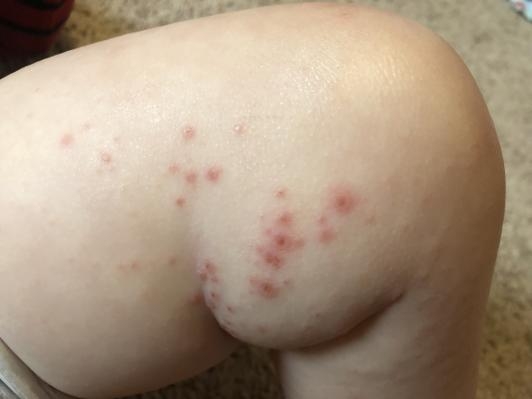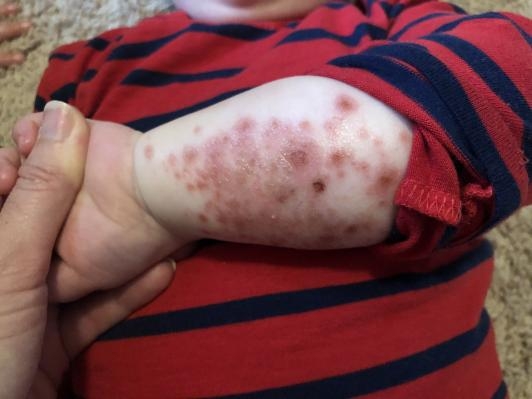7/19/21 blog post
what are those mysterious red bumps?
hand, foot, and mouth disease on the rise this summer
Over the last few weeks, Dayton Children’s Kids Express has been seeing a common theme… kids with hand, foot, and mouth disease.
“Hand, foot and mouth usually hits our area in May and June but it is hitting a little later this year than normal,” says Dr. Lisa Ziemnik, division chief of Dayton Children’s Kids Express and urgent care. “I believe we are seeing more of it this year because fewer kids have natural immunity to the virus due to last year’s quarantine. This is making them more susceptible as they are exposed to germs this summer.”
If you’ve never heard of this pesky virus you may be wondering what to keep an eye out for.
We’re breaking down the details of everything you need to know.

What is hand, foot and mouth disease (HFM) ?
Hand, foot, and mouth disease (HFM) is a common viral infection that causes painful red blisters in the mouth and throat, and on the hands, feet, and diaper area. Symptoms usually occur within three to six days from exposure.
HFM is contagious and easily spreads to others through contact with unwashed hands, feces (poop), saliva (spit), mucus from the nose, or fluid from the blisters. Kids under age 5 are most at risk for HFM, as infections are common in childcare centers, preschools, and other places where kids are in close quarters.
Besides the blisters, kids often have a fever for a few days and can get dehydrated because it hurts to swallow liquids. Symptoms usually clear up within a week and kids recover completely.
There's no cure for HFM and no vaccine to prevent it, but your doctor can recommend home care to make your child more comfortable during recovery.
What are the signs and symptoms of hand, food and mouth disease (HFM)?
The telltale sign of HFM are red blisters that usually develop one to two days into the illness. They may appear on the soles of the feet or the palms of the hand and look like flat red spots or red blisters.
The rash may also appear on other parts of the body such as the buttocks, thighs and arms. However, some kids will have no problems other than sores in the back of the throat.
It can be hard for parents to tell if a child (especially a very young one) has HFM if sores are only inside the mouth or throat. Very young kids might not be able to communicate that they have a sore throat, but if a child stops eating or drinking, or wants to eat or drink less often, it's a sign that something is wrong.
A child with HFM also might:
- have a fever, muscle aches, or other flu-like symptoms
- become irritable or sleep more than usual
- begin drooling (due to painful swallowing)
- only want to drink cold fluids
How is hand, foot and mouth disease treated?
Unfortunately there is no specific treatment or antibiotic that can be given for hand, foot and mouth. You will want to do your best to keep your child comfortable and let the virus run it’s course. HFM can last one to two weeks.
- Give your child acetaminophen or ibuprofen if your child is achy or irritable.
- Cold foods like ice cream, smoothies, and popsicles also help by numbing the area, and will be a welcome treat for kids who have trouble swallowing (and even those who don't!).
- Avoid hot drinks, sodas, and acidic food (citrus juice, tomato sauce, etc.) because they can make the pain worse.
- Kids with blisters on their hands or feet should keep the areas clean and uncovered. Wash the skin with lukewarm soap and water, and pat dry.
- If a blister pops, dab on a bit of antibiotic ointment to help prevent infection and cover it with a small bandage.
- Make sure your child drinks plenty of fluids to stay hydrated.
- Call your doctor if your child remains very fussy, can't be comforted, is sluggish, or seems to be getting worse. Also call if you see signs of dehydration, like a dry or sticky mouth, sunken eyes, or decreased urine output.
Can my child go to school/camp/childcare if they have hand, foot and mouth diease?
To prevent the spread of HFM, keep kids home from school and childcare while they have a fever or open blisters on the skin and in the mouth.
Can adults get hand, foot and mouth disease?
While not as common, adults can get HFM. They usually experience milder symptoms but sometimes have severe symptoms as well. The treatment is the same for adults as it is for children.
Can hand, foot, and mouth disease be prevented?
Hand washing is the best protection. Remind everyone in your family to wash their hands well and often, especially after using the toilet or changing a diaper, and before preparing or eating food.
Shared toys in childcare centers should be cleaned often with a disinfectant because many viruses can live on objects for a few days.
If your child has been exposed, symptoms of the disease will appear within three to six days if they have contracted the disease.




